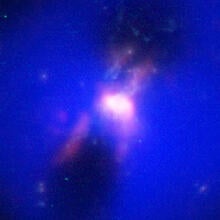
A new look at the universe and galaxy formation
Professor Brian McNamara will use the James Webb Space Telescope to study how the most massive galaxies form

Professor Brian McNamara will use the James Webb Space Telescope to study how the most massive galaxies form
By Elizabeth Kleisath Faculty of ScienceThe world watched breathlessly as the James Webb Space Telescope (JWST) launched on Christmas morning and travelled 1.5 million kilometers to its earth-trailing orbit. Now, we breathe a sigh of relief as the telescope has begun sending us the first images as it aligns and prepares for research, launching a new chapter in humanity’s endeavor to study the universe.
 Brian McNamara, Chair of the Department of Physics and Astronomy and University Research Chair at the University of Waterloo, has been following the development of JWST for almost 3 decades. He is among the lucky astronomers who has been awarded time to use the telescope (see NASA's 286 selected proposals).
Brian McNamara, Chair of the Department of Physics and Astronomy and University Research Chair at the University of Waterloo, has been following the development of JWST for almost 3 decades. He is among the lucky astronomers who has been awarded time to use the telescope (see NASA's 286 selected proposals).
“The James Webb telescope is a phenomenal achievement we all share and can be proud of,” says McNamara. “We are entering exciting years of discovery as astronomers use the telescope to study the cosmos from exoplanets to primeval galaxies.”
 Credit: ALMA (ESO/NAOJ/NRAO) H.Russell, et al.; NASA/ESA Hubble; NASA/CXC/MIT/ M.McDonald et al.; B. Saxton (NRAO/AUI/NSF)
Credit: ALMA (ESO/NAOJ/NRAO) H.Russell, et al.; NASA/ESA Hubble; NASA/CXC/MIT/ M.McDonald et al.; B. Saxton (NRAO/AUI/NSF)
McNamara’s focus will be on an object about 6 billion light years away called Phoenix, a giant galaxy that appears to be forming from its surrounding gas. Alongside Professor Michael McDonald from Massachusetts Institute for Technology and a team of collaborators, McNamara’s research will focus on the supermassive black hole at the heart of Phoenix to study how it regulates the galaxy’s growth and formation. Currently, galaxy formation is not well understood, but astronomers think that the cooling of extremely hot (100 million degree) plasma, controlled by nearby supermassive black holes, is what creates some new galaxies over billions of years.
“We’re trying to understand how this cooling process works,” says McNamara. “We see an enormous amount of mass cooling in the Phoenix Cluster at 100 million degrees, and we see a lot of cold gas at 30 degrees Kelvin, but not as much as we’d expect. So we’re trying to figure out where the gas is going.”
Using the JWST, McNamara and his collaborators will use neon gas at temperatures of several thousand degrees which lies in the mid temperature range of the cooling process. By observing how this mid-temperature gas is distributed throughout the galaxy cluster, the team will track how the enormous energy released by the supermassive black hole is dispersing the gas, a process thought to be an integral part of galaxy formation.
The JWST is the perfect tool to make these measurements. The space-based telescope permits a measurement of the neon gas in infrared light, which does not penetrate earth’s atmosphere. JWST was designed to observe the cosmos at infrared wavelengths with unprecedented sensitivity.
McNamara and his team will “stare” at Phoenix with JWST for just over eight hours in the 2022 timeframe. “It’s a long time to stare at one object in the sky. With a telescope this powerful and performing perfectly, as the spectacular first light image shows, the results will be breathtaking. I can’t wait to see the exciting discoveries the telescope will reveal in the next few years.”

Read more
Professor Michel Fich helps paint the most complete picture ever of how water ends up on newly forming planets

Read more
Waterloo astrophysicist and global team of scientists bring into view black hole’s powerful jets, and how they impact the formation and structure of galaxies

Read more
Gravitational echoes may confirm the late Stephen Hawking’s quantum black hole hypothesis
The University of Waterloo acknowledges that much of our work takes place on the traditional territory of the Neutral, Anishinaabeg, and Haudenosaunee peoples. Our main campus is situated on the Haldimand Tract, the land granted to the Six Nations that includes six miles on each side of the Grand River. Our active work toward reconciliation takes place across our campuses through research, learning, teaching, and community building, and is co-ordinated within the Office of Indigenous Relations.